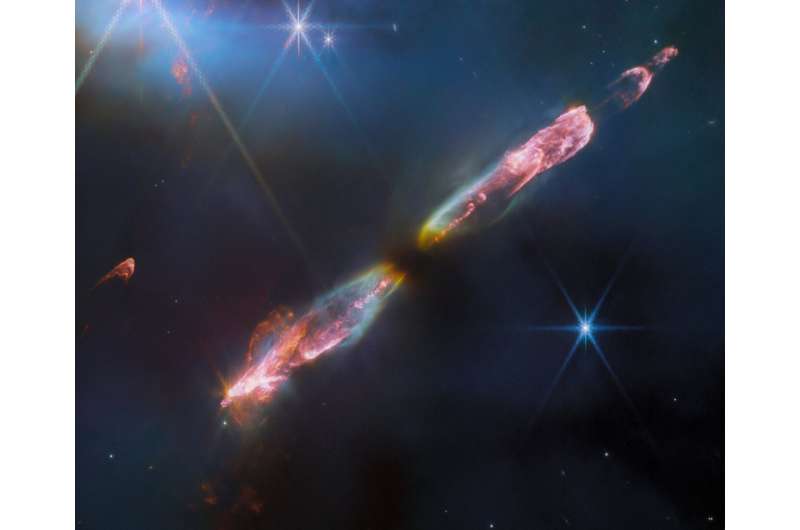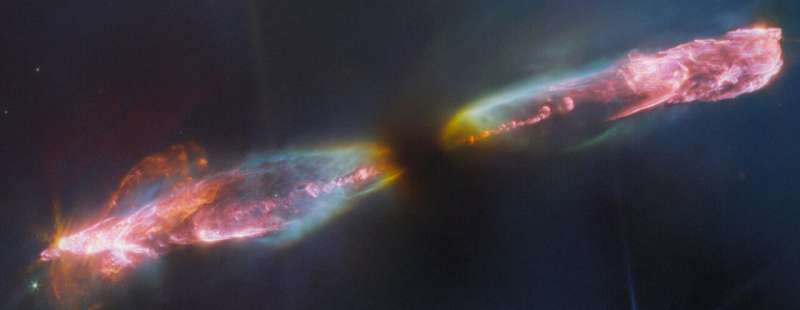This article has been reviewed according to Science X's editorial process and policies. Editors have highlighted the following attributes while ensuring the content's credibility:
fact-checked
trusted source
proofread
Webb snaps supersonic outflow of young star

NASA's James Webb Space Telescope has captured a high-resolution look at Herbig-Haro 211 (HH 211), a bipolar jet traveling through interstellar space at supersonic speeds. At roughly 1,000 light-years away from Earth in the constellation Perseus, the object is one of the youngest and nearest protostellar outflows, making it an ideal target for Webb.
Herbig-Haro (HH) objects are luminous regions surrounding newborn stars, formed when stellar winds or jets of gas spewing from these newborn stars form shock waves colliding with nearby gas and dust at high speeds. This image of HH 211 from NASA's James Webb Space Telescope reveals an outflow from a Class 0 protostar, an infantile analog of our sun when it was no more than a few tens of thousands of years old and with a mass only 8% of the present-day sun. (It will eventually grow into a star like the sun.)
Infrared imaging is powerful in studying newborn stars and their outflows, because such stars are invariably still embedded within the gas from the molecular cloud in which they formed. The infrared emission of the star's outflows penetrates the obscuring gas and dust, making a Herbig-Haro object like HH 211 ideal for observation with Webb's sensitive infrared instruments. Molecules excited by the turbulent conditions, including molecular hydrogen, carbon monoxide, and silicon monoxide, emit infrared light that Webb can collect to map out the structure of the outflows.

The image showcases a series of bow shocks to the southeast (lower-left) and northwest (upper-right) as well as the narrow bipolar jet that powers them. Webb reveals this scene in unprecedented detail—roughly 5 to 10 times higher spatial resolution than any previous images of HH 211. The inner jet is seen to "wiggle" with mirror symmetry on either side of the central protostar. This is in agreement with observations on smaller scales and suggests that the protostar may in fact be an unresolved binary star.
Earlier observations of HH 211 with ground-based telescopes revealed giant bow shocks moving away from us (northwest) and moving towards us (southeast) and cavity-like structures in shocked hydrogen and carbon monoxide respectively, as well as a knotty and wiggling bipolar jet in silicon monoxide. Researchers have used Webb's new observations to determine that the object's outflow is relatively slow in comparison to more evolved protostars with similar types of outflows.
The team measured the velocities of the innermost outflow structures to be roughly 48-60 miles per second (80 to 100 kilometers per second). However, the difference in velocity between these sections of the outflow and the leading material they're colliding with—the shock wave—is much smaller. The researchers concluded that outflows from the youngest stars, like that in the center of HH 211, are mostly made up of molecules, because the comparatively low shock wave velocities are not energetic enough to break the molecules apart into simpler atoms and ions.
The paper is published in the journal Nature.
More information: T. P. Ray et al, Outflows from the Youngest Stars are Mostly Molecular, Nature (2023). DOI: 10.1038/s41586-023-06551-1 , www.nature.com/articles/s41586-023-06551-1
Provided by Space Telescope Science Institute




















